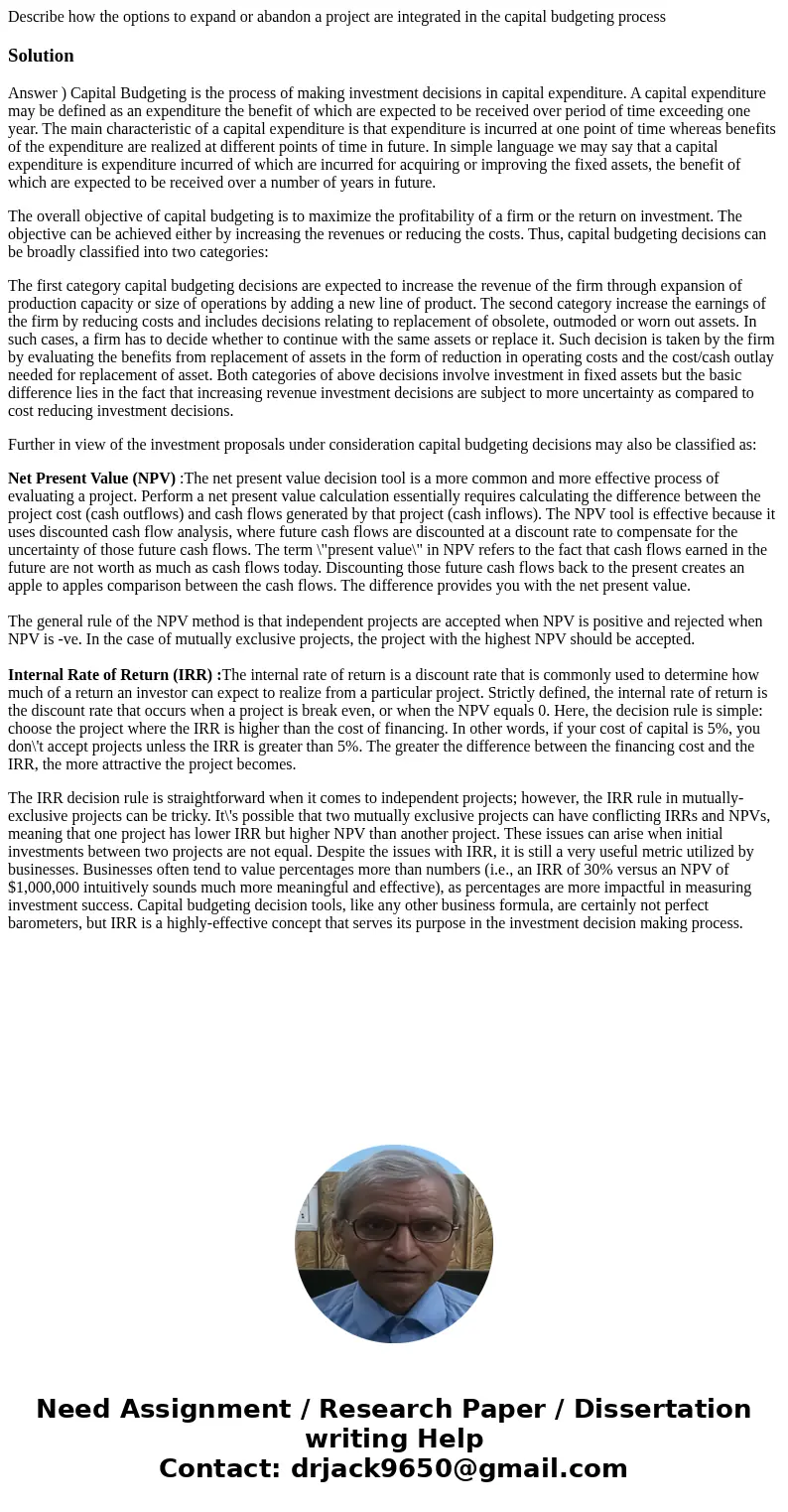Describe how the options to expand or abandon a project are
Describe how the options to expand or abandon a project are integrated in the capital budgeting process
Solution
Answer ) Capital Budgeting is the process of making investment decisions in capital expenditure. A capital expenditure may be defined as an expenditure the benefit of which are expected to be received over period of time exceeding one year. The main characteristic of a capital expenditure is that expenditure is incurred at one point of time whereas benefits of the expenditure are realized at different points of time in future. In simple language we may say that a capital expenditure is expenditure incurred of which are incurred for acquiring or improving the fixed assets, the benefit of which are expected to be received over a number of years in future.
The overall objective of capital budgeting is to maximize the profitability of a firm or the return on investment. The objective can be achieved either by increasing the revenues or reducing the costs. Thus, capital budgeting decisions can be broadly classified into two categories:
The first category capital budgeting decisions are expected to increase the revenue of the firm through expansion of production capacity or size of operations by adding a new line of product. The second category increase the earnings of the firm by reducing costs and includes decisions relating to replacement of obsolete, outmoded or worn out assets. In such cases, a firm has to decide whether to continue with the same assets or replace it. Such decision is taken by the firm by evaluating the benefits from replacement of assets in the form of reduction in operating costs and the cost/cash outlay needed for replacement of asset. Both categories of above decisions involve investment in fixed assets but the basic difference lies in the fact that increasing revenue investment decisions are subject to more uncertainty as compared to cost reducing investment decisions.
Further in view of the investment proposals under consideration capital budgeting decisions may also be classified as:
Net Present Value (NPV) :The net present value decision tool is a more common and more effective process of evaluating a project. Perform a net present value calculation essentially requires calculating the difference between the project cost (cash outflows) and cash flows generated by that project (cash inflows). The NPV tool is effective because it uses discounted cash flow analysis, where future cash flows are discounted at a discount rate to compensate for the uncertainty of those future cash flows. The term \"present value\" in NPV refers to the fact that cash flows earned in the future are not worth as much as cash flows today. Discounting those future cash flows back to the present creates an apple to apples comparison between the cash flows. The difference provides you with the net present value.
The general rule of the NPV method is that independent projects are accepted when NPV is positive and rejected when NPV is -ve. In the case of mutually exclusive projects, the project with the highest NPV should be accepted.
Internal Rate of Return (IRR) :The internal rate of return is a discount rate that is commonly used to determine how much of a return an investor can expect to realize from a particular project. Strictly defined, the internal rate of return is the discount rate that occurs when a project is break even, or when the NPV equals 0. Here, the decision rule is simple: choose the project where the IRR is higher than the cost of financing. In other words, if your cost of capital is 5%, you don\'t accept projects unless the IRR is greater than 5%. The greater the difference between the financing cost and the IRR, the more attractive the project becomes.
The IRR decision rule is straightforward when it comes to independent projects; however, the IRR rule in mutually-exclusive projects can be tricky. It\'s possible that two mutually exclusive projects can have conflicting IRRs and NPVs, meaning that one project has lower IRR but higher NPV than another project. These issues can arise when initial investments between two projects are not equal. Despite the issues with IRR, it is still a very useful metric utilized by businesses. Businesses often tend to value percentages more than numbers (i.e., an IRR of 30% versus an NPV of $1,000,000 intuitively sounds much more meaningful and effective), as percentages are more impactful in measuring investment success. Capital budgeting decision tools, like any other business formula, are certainly not perfect barometers, but IRR is a highly-effective concept that serves its purpose in the investment decision making process.

 Homework Sourse
Homework Sourse